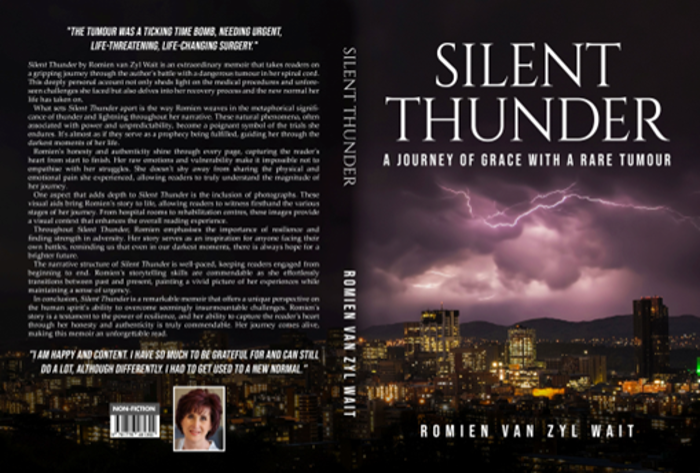Silent Thunder - A Journey of Grace with a Rare Tumour

Name: Romien Van Zyl Wait
Type of Cancer: Spinal Ependymoma
Diagnosed: 2017
By: Romien W.
— Categories:
Adult
Spine
How it Started
On, what I thought would be another perfectly ordinary day, I received devastating news that I had a very rare tumour inside my spinal cord, which could eventually leave me paralysed, even if treated. I instantly knew this was a journey I had to be on and that it would be part of me for the rest of my life. I knew that my struggles would be used to help others; therefore, I was willing – and eager in a strange way – to go through this and that one day, I could tell my story, which would become part of someone else's survival.
One in a million people worldwide gets diagnosed with an intramedullary spinal cord tumour. If South Africa has a population of 58 million people, it means that only 58 people in South Africa have such a tumour. The tumour was a ticking time bomb, needing urgent, life-threatening, life-changing surgery. At the time, I was happy, a career woman, loved my job and I could never imagine doing anything else. Not for one minute did I ever think that this could all end and that I would be an incomplete paraplegic a few years later.
Writing My Story
Through writing the book, Silent Thunder – A Journey of Grace with a Rare Tumour, I wanted to share my experience and journey with everyone interested in reading it. Extracts from the free downloadable ebook are included below as a brief snap shot of the full text.
Prognosis, Diagnosis and Devastation
I realised what a lousy card I was dealt. The prognosis was that if we left the tumour, it would eventually paralyse me from the neck down. The tumour had to be removed, which is a high risk, and surgery could also paralyse me from the neck down. As we drove back from the doctor’s office on one of our pre-op visits, the song Moonshadow by Cat Stevens played on the radio. I heard the words, ‘If I ever lose my legs, I won’t have to walk no more,’ and that was when I decided that I wanted to get through this as I DO want to walk again. And I WILL WALK AGAIN!
When we arrived home, I did some research about the song. An upbeat yet depressing song! Moonshadow is about a stalker; in this case, my stalker was the tumour. Just like the stalker is put in his place in this song, I was determined to put my “stalker” in its place.
According to his website, Cat Stevens captured the feeling of walking alone in a natural place with the moon’s light to accompany him and then provided speculation as to the meaning of life. This song is about how we are all stalked by the dark possibility of tragedy, but he has decided he will not let it oppress him. In fact, he plays with it (leaping and hopping on a moon shadow) by finding something freeing in any tragedy. I remembered that I promised my daughters, after their father died that I would be the one to walk them down the aisle when they got married one day, and I was just not prepared to settle for less.
The first few days after the surgery
My neurosurgeon’s words were chilling: “The tumour, the size of my thumb, was pushing relentlessly on your spinal cord. You had very little time before complete paralysis.” They told me before surgery that if I could move my toes after surgery, I would be able to learn to walk again, most probably with aid. Immediately after surgery, I felt no sensation below my upper chest and had no movement in my legs and feet. I could only move my toes very slightly and was numb from the chest down to my feet. Physiotherapists use The Berg Balance Scale (BBS) to objectively determine a patient's ability (or inability) to balance safely during a series of predetermined tasks. On the BBS, an average person tests 56/56. A score of 56 indicates functional balance. A score of <45 indicates individuals may be at greater risk of falling. At this time, my BBS test measured 0/56.
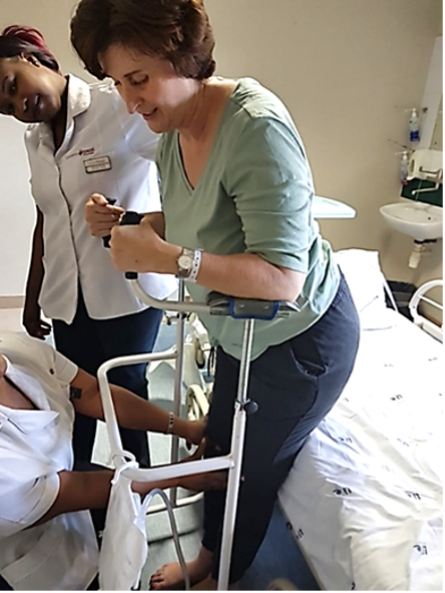 Day 5 was a lot harder than I imagined. I thought to lay in the ICU on my back and be able to move my toes and feet was an accomplishment, but it was not. I never imagined how difficult this would be, but then I got a taste of it. I had to learn that I was paralysed from the chest down. I had to learn that everything from the chest down is dead weight. And I could do nothing with that part of my body. Without assistance, I could not move my legs to sit in bed or reposition myself. The nursing and physio staff helped me to put my legs towards the side of the bed and then wanted me to roll over and sit on the side of the bed, with my legs hanging off the side. I could not do it. Although I tried hard, my body did not want to work with me. We would try again every day. I just never realised exactly how hard this was going to be. On Day 7 I finally managed, with the help of physio therapists, to sit on the side of the bed! I remember also being able to swing my legs very slightly to the front and back again. It felt wobbly. It felt like sitting on a waterbed, I had no sense of my core muscles. I did not know where they were and could not feel them. Not a secure feeling at all. On Day 13 they got me "standing", but don't be fooled. They got me "standing" today, but don't be fooled. When you hear that a spinal cord patient stood for the first time, it means they are hanging on a frame, supported by their elbows with no assistance from their legs. You do this every day for your brain to keep remembering what it feels like to be standing upright. Lots of overcompensation in the arms and elbows, but it was a move forward while continuing with leg exercises as often as possible during the day. I sat up at least with each meal and did my sitting exercises daily. Lying down too much will deteriorate the body. Then again, there was not much I could do with the "dead weight", and I did not know if any of the sensations would ever return, but at least I had a lot to work with.
Day 5 was a lot harder than I imagined. I thought to lay in the ICU on my back and be able to move my toes and feet was an accomplishment, but it was not. I never imagined how difficult this would be, but then I got a taste of it. I had to learn that I was paralysed from the chest down. I had to learn that everything from the chest down is dead weight. And I could do nothing with that part of my body. Without assistance, I could not move my legs to sit in bed or reposition myself. The nursing and physio staff helped me to put my legs towards the side of the bed and then wanted me to roll over and sit on the side of the bed, with my legs hanging off the side. I could not do it. Although I tried hard, my body did not want to work with me. We would try again every day. I just never realised exactly how hard this was going to be. On Day 7 I finally managed, with the help of physio therapists, to sit on the side of the bed! I remember also being able to swing my legs very slightly to the front and back again. It felt wobbly. It felt like sitting on a waterbed, I had no sense of my core muscles. I did not know where they were and could not feel them. Not a secure feeling at all. On Day 13 they got me "standing", but don't be fooled. They got me "standing" today, but don't be fooled. When you hear that a spinal cord patient stood for the first time, it means they are hanging on a frame, supported by their elbows with no assistance from their legs. You do this every day for your brain to keep remembering what it feels like to be standing upright. Lots of overcompensation in the arms and elbows, but it was a move forward while continuing with leg exercises as often as possible during the day. I sat up at least with each meal and did my sitting exercises daily. Lying down too much will deteriorate the body. Then again, there was not much I could do with the "dead weight", and I did not know if any of the sensations would ever return, but at least I had a lot to work with.
I often touched my legs with my hands to ensure they were still there. I started to realise that life would never be the same. A positive attitude and faith go a long way. In the days, weeks, and months that were to come, I would learn more about the importance of these attributes. I was basically a quadriplegic at that stage, but the fact that I had movement in my feet meant that I would be able to walk again. It would take six months to two years for recovery.
Complications
Up to this point, I had every textbook complication this surgery could present. I had to deal with paraplegia, a seroma, haematoma, a pulmonary embolism and a spinal cord fluid leak. While still in hospital I had to go back to surgery several times and every time it felt like I had to start all over again.
On day 106, after being in hospital for almost four months, I was finally discharged and could go home.
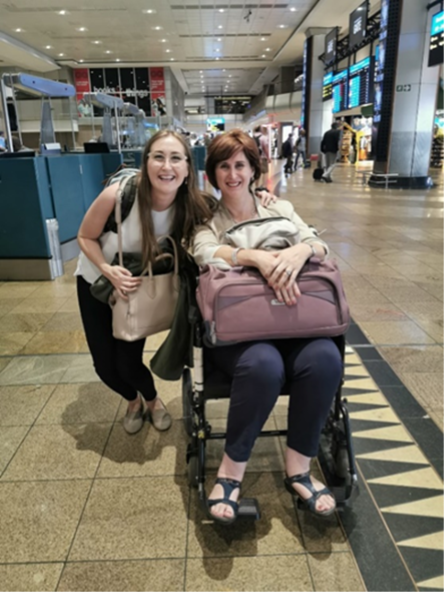 Challenges once back home
Challenges once back home
During this recovery process and the new normal in my life, I have learned that I need to accept that nothing I do will ever again look feminine (stylish). My wardrobe changed to more relaxed clothing and as I can now only wear sneakers or similar shoes, which allows for my shoe inners and ankle guards to support me while walking, my clothes toned down to match my shoes. I walk funny and slow. When I need to climb stairs, it looks like I am stalking them in my approach with all the walking aid and people assisting me. When attending a wedding or more “dressy” occasion, I have the “shoe issue” and it doesn’t matter how beautiful the dress is, I wear it with sneakers. Hence my complete approach towards style has changed. My once corporate wardrobe now consists of sport and leisure wear. It did take some time to get used to, but I now enjoy the more comfortable look and lifestyle.
Never Losing Sight of the Goal
The one thing I never lost sight of was the goal of being able to walk my daughters down the aisle on their wedding days. When my daughter got married, I could walk her down the aisle, with aid.
Where I am Today
I am so fortunate to have come this far, and I wish I could say that I have fully recovered, but my recovery is far from that. No one can predict what your recovery will be. It is different for every individual. For me, all the deficits I had before surgery are still there, with a few more. I am happy and content. I have so much to be grateful for and can still do a lot, although differently. I had to get used to a new normal. The new me is always late. Everything takes a lot longer. We need to plan and allow for that. I use walking aids and for long distances, a wheelchair. Pain and neuropathic pain are part of my everyday life. My feet feel cold as ice all the time, but when you touch them, they are not cold. For me, it feels so cold that it causes pain. The mind is powerful, and sometimes I wear fluffy warm socks and imagine that it heats my feet and comforts me, and for a very short few minutes, I act out the fantasy of normal temperature in and on my feet. A part of these tumours/spinal injuries is that it causes a tightness, almost like somebody has your feet in a bench vice grip, tightening it as tight as possible and never letting it go.
I have the same tight pressing and painful pain band around my chest. That was one of the symptoms before diagnosis and surgery, and it will be with me for the rest of my life. Imagine somebody tightening a wide solid leather belt around your chest and pulling it tighter. That is what it feels like all the time. While my feet feel cold, my legs always have a hot burning sensation – almost as if the nerve points are on fire. Spasms (shocks every 20–30 seconds) in my legs are so often that I sometimes do not know if I should sit, stand, lie down, scream, cry or laugh, as nothing brings comfort. Hence, I try to keep busy to not focus on the pain. The emotional and physical strain is a daily challenge. Besides pain, my body feels uncomfortable all the time. The new normal and my disability will be with me for the rest of my life, which is okay. At least I can walk and am mobile to a certain extent.
I do struggle with self-confidence from time to time. In my close-knit circle, I am fine, but the stares at public events and places can sometimes be overwhelming and get to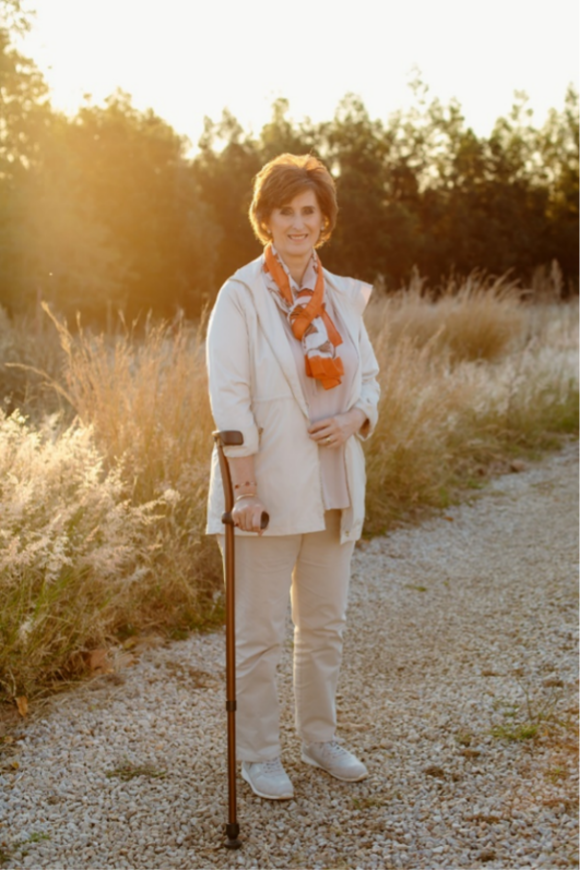 even the most confident of us. When we are at an event, I prefer to sit in a corner and not mingle too much, as I sometimes get overwhelmed and embarrassed to get up in front of people. When we plan holidays, we plan it with my disability and mobility issues in mind. It is more stressful to be with people I do not know, as they are unaware of the challenges, and although I do not mind people asking questions, I do not feel up to discussing and being reminded of my situation all the time. I feel comfortable and happy when it is only my close circle with me on holiday, as they know what we are dealing with and accept and overcome challenges with me as we progress.
even the most confident of us. When we are at an event, I prefer to sit in a corner and not mingle too much, as I sometimes get overwhelmed and embarrassed to get up in front of people. When we plan holidays, we plan it with my disability and mobility issues in mind. It is more stressful to be with people I do not know, as they are unaware of the challenges, and although I do not mind people asking questions, I do not feel up to discussing and being reminded of my situation all the time. I feel comfortable and happy when it is only my close circle with me on holiday, as they know what we are dealing with and accept and overcome challenges with me as we progress.
Most of the time, my coping mechanism is to ignore the situation and focus on something else; hence, I am always busy with a hobby or some charity. The minute I let my guard down and take the focus off these things is when it can sometimes hit me hard. Society can be cruel. Sometimes reality hits me (sometimes hard to swallow), and I realise and think of what I have lost and how different the new normal from my old normal life is. And then I allow myself the luxury of being sad and the luxury of mourning. It is not a once-off event; mourning and coping with loss is a process. I still need to learn the timeline. Maybe it takes a lifetime…
Sadly, my mobility and physical issues are not the only loss I had to deal with. Sometimes you find yourself in a situation where somebody you thought was a close friend cannot deal with the fact that you have a new normal and decide to walk away from the friendship and your life. It takes a long time to deal with the loss of a perfectly healthy “friend” who decided that they could not deal with your loss. Sadly, people in my situation must deal with problems like this often. Expect to have people exit your life when your normal change. The beautiful part is that I made me new friends who really care, and we will be by each other’s sides for the rest of our lives. Some of them are perfectly healthy, and some are also disabled. And for that, I am truly grateful! I have accepted that I can no longer do my high-profile full-time job as Head of Corporate Governance and Finance at an international pharmaceutical company. I used to live for my job and got so much satisfaction from it. If someone had told me a couple of years ago that I would not be a career woman anymore and enjoy my life without it, I would not have believed it. Watch Romien's interview for more insight into her journey.
Now things have changed, I have a new normal, and I am happy with what life has given me. I have found ways within my circumstances to enjoy life and be fulfilled. Within my abilities, I still mentor youngsters, both career and hobby-wise. I enjoy sharing my knowledge and love to empower people who would not otherwise have the opportunity.
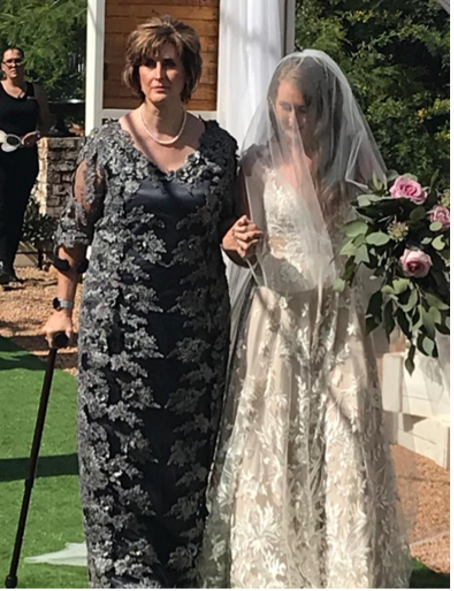
I could walk (with aid) my daughters down the aisle on their wedding days. I feel super blessed and have so much to be thankful for. Photo Grace Photography and Lara Photography.

